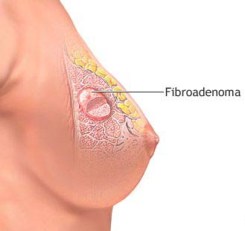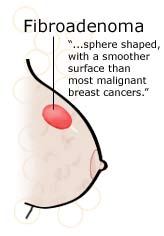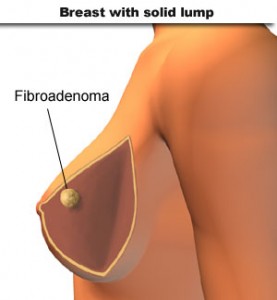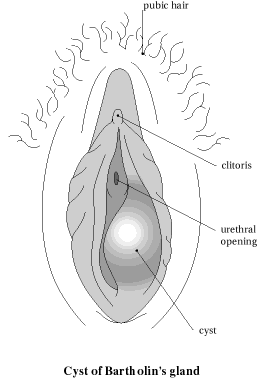Are you having a hard, painless lump on either of your breasts? Watch out, for these are signs of a slowly growing Fibroadenoma. Read on to know what is a Fibroadenoma, its causes, symptoms, diagnosis and treatment.
What Is Fibroadenoma Of The Breast?
Page Contents

Picture 1 – Fibroadenoma
Source – womenhealthzone
The term ‘Fibroadenoma’ refers to small, solid lumps or tumors arising on the breast. These are benign or non-cancerous and consist of glandular and fibrous tissues. These breast tumors are quite common in women, particularly those of reproductive age or under 40 years. Fibroadenoma tumors occur in clusters in about 10-15% of sufferers.
Fibroadenomas are the second most common non-cancerous breast tumors arising in women.
Fibroadenoma Types
Some of the major types of Fibroadenoma breast tumors are :
Juvenile Fibroadenoma
Juvenile Fibroadenoma is the name given to a pattern of Fibroadenoma witnessed in patients below 20 years of age. In case of a Juvenile Fibroadenoma, the tumor has greater amount of animal tissue in the cells.
Giant Fibroadenoma
This is usually a Fibroadenoma of great size. A Giant Fibroadenoma is typically over 68 cm in diameter and is the result of increase of connective tissue in the tumors.
Lactating Fibroadenoma
Also known as Lactating Adenoma, this growth forms during pregnancy and grows rapidly with increase in secretions.
Fibroadenoma Symptoms
Fibroadenoma is characterized by the development of one or more firm, painless bumps on either of the breasts. These are smooth and move under the skin surface on touch.
Fibroadenomas in breast may grow in size though they mature slowly in most sufferers. The growth of Fibroadenoma is usually seen during pregnancy. Fibroadenoma is usually asymptomatic. There are almost no symptoms of Fibroadenoma. Fibroadenoma growths can, however, lead to some amount of physical discomfort when large in size.
In case of an enlarged Fibroadenoma pain can also arise in some sufferers. The growth can hurt when touched in such cases. A painful Fibroadenoma can be a sign of complicated conditions such as malignant tumors. Fibroadenoma usually gives rise to non-cyclic pain in patients.
Fibroadenoma Causes
Medical research has been yet unable to establish the exact reason for the occurrence of Fibroadenoma. Hormonal imbalance is, however, supposed to be the main reason for this condition. This is due to the fact that the tumors are seen in pregnant, premenopausal or postmenopausal women. These are the times when hormone levels rapidly change in the body.
Fibroadenoma breast lumps are also seen in women who are undergoing Hormone Replacement Therapy (HRT). Women on estrogen therapy are susceptible to these benign tumors.
Fibroadenoma Diagnosis
The diagnosis of Fibroadenoma of breast begins with a physical examination of the sufferer. In most cases of Fibroadenoma ultrasound of the breast or a mammogram examination is done immediately after this.
A breast biopsy is also carried out to make a proper diagnosis. This is usually performed to rule out cancerous conditions. Three kinds of breast biopsies are performed. Though Sterotactic and Open biopsies are effective, it is Core Needle Breast Biopsy that is generally carried out. A biopsy is usually unnecessary in women in teen years or in their early 20s.
As breast lump Fibroadenomas are mostly asymptomatic, it is usually detected while women conduct medical breast exams.
Fibroadenoma Treatment
In the absence of any symptoms, medical Fibroadenoma cure is usually not advised. It is most often left undisturbed and periodically checked to detect any enlargement. In case of periodic checking of the size of Fibroadenoma mammogram is a trusted examination. However, patients often go for treatment due to the embarrassment that a breast lump causes to them.
Fibroadenoma tumors are generally removed with the aid of Lumpectomy. This involves surgical removal of the tumor without removing the adjoining Fibroadenoma breast tissues or lymph nodes. This type of Fibroadenoma removal surgery is fairly easy and generally takes a short time to carry out.
Fibroadenoma removal can also be done when an open biopsy is being carried out for diagnosis. Such a biopsy is known as Excisional Biopsy. This kind of treatment is done based on the features of the growth.
Alternative Treatment for Fibroadenoma
Fibroadenoma can also be treated with the aid of Cryoablation, a process that involves use of controlled freezing for destroying tissues. Needle aspiration is another effective way used for removal of Fibroadenoma.
Fibroadenoma Prognosis
Following surgery of Fibroadenoma breast pain and soreness are some of the common symptoms in patients. Sufferers are advised to avoid heavy activities and exercises for 2-3 weeks after operation. If lumps are not removed, they should be periodically checked with the help of imaging tests and physical exams to detect any increase in size.
Fibroadenoma And Cancer
As aforesaid, Fibroadenoma is a benign condition. There is no risk of cancer from benign Fibroadenoma breast growths. There is no reported case of Fibroadenoma breast cancer. However, patients of Fibroadenoma have a slightly greater risk of developing breast cancer later in their life.
If a Fibroadenoma growth is not removed, it needs to be periodically checked to note any enlargement in size. An enlarged breast lump may be a symptom of some underlying condition. Fibroadenoma is a benign growth but there is a risk of cancerous developments as they contain epithelium. There is approximately 3% chance of breast carcinoma from Fibroadenoma tumors.
Fibroadenoma Pictures
Want to know how breast Fibroadenomas look like? Here are some useful Fibroadenoma breast lump images that will give you an idea about the appearance of these growths.

Picture 2 – Fibroadenoma Image
Source – treesd

Picture 3 – Fibroadenoma Photo
Source – riversideonline
If you have a lump on your breast that is growing and is seemingly unaffected by menstrual cycle, it is advisable that you get in touch with a good doctor and go for an early diagnosis. It will help detect Fibroadenoma, if there is one, and cure it at the earliest.
References:
http://www.nlm.nih.gov/medlineplus/ency/article/007216.htm
http://breastcancer.about.com/od/mammograms/p/fibroadenomas.htm
http://www.ncbi.nlm.nih.gov/pubmedhealth/PMH0004482/
http://emedicine.medscape.com/article/345779-overview
https://health.google.com/health/ref/Fibroadenoma+-+breast
http://www.wisegeek.com/what-is-fibroadenoma.htm
http://www.wrongdiagnosis.com/f/fibroadenoma/intro.htm


well i do feel some pains in my breat as well,,,,,,so i went to see a doctor he said i should go and check about this fibroademnoma online……so i just read thru it,,,,,,i will be going for check up…so as to know if i hav it,,,,,and treat it immediately…..i just read thru and i now knw wht i needed 2 knw abi it….cheers
can fibroadenoma get removed in pregnancy?